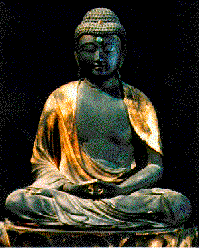 Answers to Common Questions about Buddhism
Answers to Common Questions about Buddhism
QUESTION:
What is the
goal of
Buddhism?
ANSWER:
The first step is letting go of attachment to wrong views- like the idea that things are permanent, or the idea that categories are real instead of just descriptive, or the idea that the universe is somehow obligated to live up to our beliefs about how things "should" be.
The second step, after giving up the attachment, is giving up the wrong views themselves, or "overcoming ignorance". In Buddhism, "ignorance" means lack of contact with the here-and-now. The traditional absent-minded professor is ignorant in that sense.
The third step is the end of suffering. After all, suffering isn't just pain. Lots of times you put up with a certain ammount of pain without it bothering you. Suffering is when what happens is different from some idea we're attached to about what "should" be happening, and we get scared, mad or resentful about it.
So the goal is a serene, unbiased perception of reality that gets rid of all suffering.
First, THE Buddha was Prince Siddhartha Gautama, in India. He was a human like us, who overcame ignorance and suffering, then taught us how we can do it too.
Second, A Buddha is anyone who reaches the same level of freedom as Shakyamuni did.
Third, it's used for some personifications of aspects of Enlightenment.
A Buddha, in the sense of anyone who attains Enlightenment, acts in whatever way is most appropriate, from an unshakable contact with reality and a total absence of ill-will.
Buddhas, in the sense of personifications, don't 'do' anything any more than 2+2=4 'does' something. They are ways of looking at things, like Jack Frost or Mother Nature- not a real person, but a symbol of something that definitely IS real. Amida Buddha, for example, means, IN PART, the reality outside our preconceptions. "He" constantly impinges on our consciousness, waiting for us to let go of our preconceptions, even for a moment. As soon as we do, He 'comes to us'. That is, we see reality as it is, and so are on our way to freedom.
But after becoming Enlightened, you don't have that kind of attachments, so you don't have to be reborn. What happens then is so different from anything we know that it can't be described.
You don't have to believe that to be Buddhist, though. After all, the real question isn't 'what happens after I die?', it's 'what's happening right now?'
Specifically, they're all exercises in helpfulness, harmlessness, patience, industriousness, living in the here-and-now, and understanding. You can use whichever ones help you.
There are certain ways of looking at things that are generally accepted, but they can vary slightly in different schools of Buddhism. All Buddhists accept the principles of cause-and-effect, impermanance, and the difference between concepts and reality.
Most of the images in Buddhism are "believed in" like lines of latitude and longitude on a map. No one thinks there are black lines around the Earth, but a lot of people would be lost without them.
Buddhism points out that nothing is eternal. In fact, since everything is in a state of constant change, there can't be any permanent unifying factor like a "soul". So we say that "self" is just a term of convenience. It doesn't really exist as a thing.
Since everything happens through cause-and-effect, miracles are out. That includes the magical creation of the universe or the human race.
Our happiness or unhappiness is based on causes, too. Having our imperfectioms "forgiven" couldn't get us out of the suffering that imperfections cause. An unenlightened person in Heaven would still be going "Well, it's good ambrosia, but it's not great ambrosia. Whaddaya mean, he's got a bigger wingspan than me? I got every bit as big a wingspan as that *~#@%" etc.etc. An enlightened person in Hell would be in pain, but it wouldn't bother him. Besides, even Heaven and Hell can't last forever.
But if you want to believe in a God who's a non-eternal non-person who can't perform miracles, who didn't create anything, whose judgments are just personal opinions, and whose rewards and punishments are nothing more than temporary annoyances, I guess Buddhism couldn't argue. But why bother?
ANSWER:
For that matter, Buddhism doesn't have "worship" the way other religions use the term. When we use these figures in rituals, it's a practice to help us develop more awareness or carefulness about the things the symbol represents. It's like saluting the flag. Nobody says that's cloth-worship, do they?
ANSWER:
This means we aren't prohibited from doing anything, either. All we're taught is how to take a good look at all the effects of what we want to do, without letting our wants cloud our vision, before we decide.
It turns out, though, that anything harmful or dishonest very seldom has the kind of results you would want.
QUESTION: What do you do at services?
ANSWER: